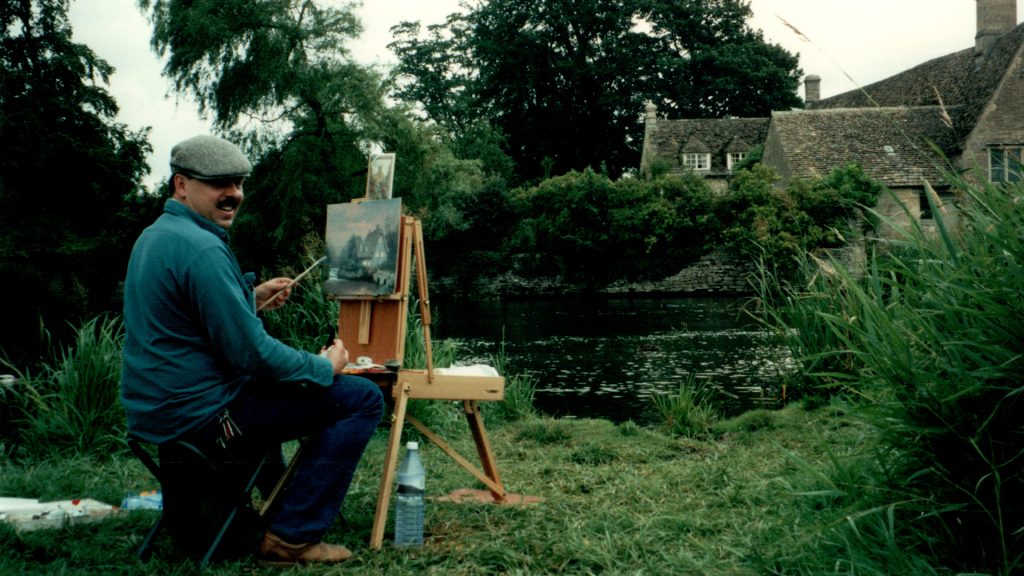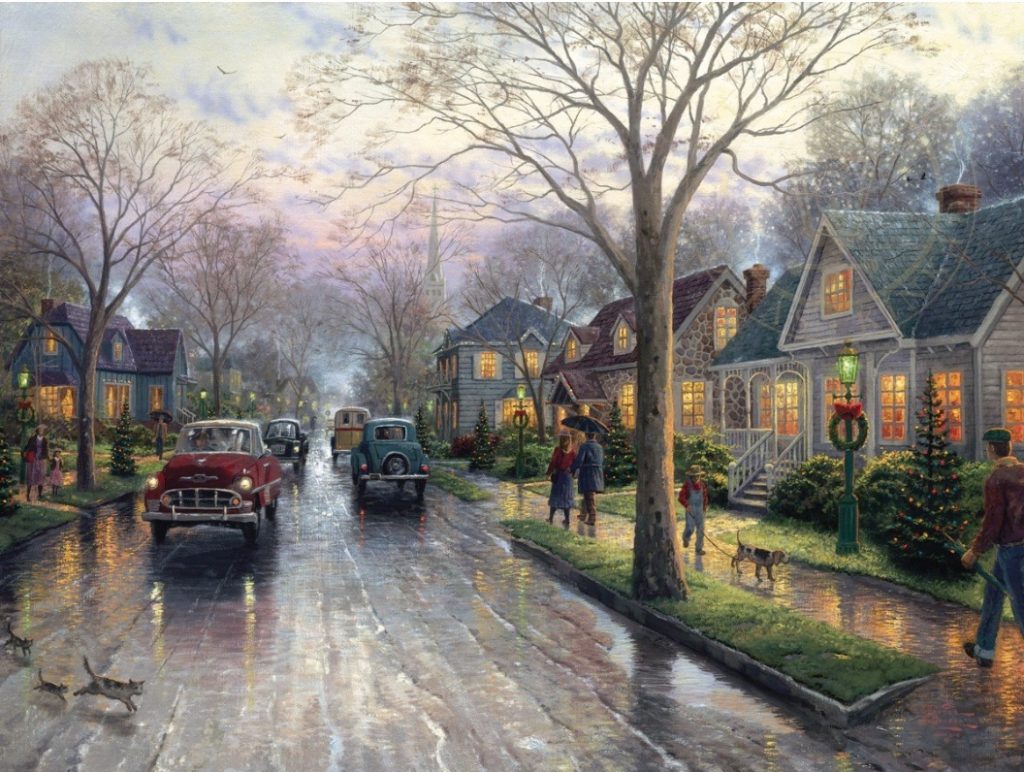Pop Culture
A Holiday-Themed Thomas Kinkade Show Takes a Fresh Look at the King of Kitsch
The exhibition opens December 1 at McLennon Pen Co. Gallery in Austin, Texas.

The exhibition opens December 1 at McLennon Pen Co. Gallery in Austin, Texas.

Devorah Lauter

In the 1990s and early 2000s, paintings by the California artist Thomas Kinkade were the art equivalent of elevator music, the ultimate kitsch cultural touchstone. They were so ubiquitous, they needed little description—think softly lit bucolic cottages and Hallmark-style scenery that doesn’t attempt to reflect reality.
That nostalgic suspension of disbelief may have been the artist’s greatest strength. At the height of his career, when his works could be found in self-branded mega-mall stores across the U.S., the self-described “Painter of Light” was so popular that it was said as many as one in 20 Americans owned one of his prints. The contemporary art world, however, never accepted him.
The artist, in turn, famously rebuffed the elitist art world. “My art is relevant because it is relevant to 10 million people,” he told The New Yorker in 2001. “That makes me the most relevant artist in current culture, not the least.”

Thomas Kinkade at his easel in Art for Everybody. Still image, courtesy of the filmmakers.
That all may be changing now. Jill McLennon, the founder of the new McLennon Pen Co. Gallery in Austin, has given Kinkade’s claim some thought. From December 1 to 23, her gallery is hosting the exhibition “Thomas Kinkade Winter Wonderland” with the help of Kinkade’s family, who gave McLennon access to their archive and consigned three original paintings to the show. The opportunity is a rare one, since Kinkade stopped selling original works once he became famous, and instead printed high-end reproductions through his company, Media Arts Group, Inc, which made more than $100 million a year at its peak.
McLennon said she was drawn to the artist after she saw the documentary Art For Everybody earlier this year. The film has brought new attention to Kinkade’s life and artworks, delving into his misunderstood, multifaceted persona and, notably, the discovery of a hidden vault of artworks in Kinkade’s home, found after his death.
According to the film, the vault’s contents are stark opposites to the Disney-esque imagery of his well-known works. Paintings are in grays and browns rather than the usual pastels, and feature industrial and urban landscapes rather than small-town Main Streets and sun-dappled, winding country roads.
For some time, it has been well-known that Kinkade, who was arguably the wealthiest living artist of his day, suffered from his own personal demons and struggled with alcohol abuse. This became more apparent leading up to his death from an alcohol and Valium overdose in 2012, at the age of 54. The contrast between the warm and glowing scenery he depicted and what became known as his “darker” side, suggested there had always been something more complex gurgling beneath the veneer of his idyllic illustrations.
Months after seeing the critically acclaimed documentary, “I was still fascinated with the artist and how someone so successful commercially had never been recognized by the art world,” McLennon told Artnet News in an email. She started searching for his work on Ebay and found troves in different formats. “I immediately gravitated towards the kitschiest works I could find,” she said, “which for me were the Christmas paintings.”
The show, which is centered around the timely holiday theme, includes a range of Kinkade memorabilia, from his snow globes and ceramic plates to a La-Z-Boy chair upholstered in Kinkade-printed fabric. To complete the scene, the gallery is hung with Christmas decorations and filled with fake snow.

Thomas Kinkade, Hometown Christmas I (2002). Photo: courtesy of McLennon Pen Co. Gallery.
While Kinkade has been in a handful of group exhibitions since his death, for this first solo show in a contemporary art gallery since his passing, McLennon feels the art world may now be ready to appreciate “his ingenuity with his marketing and licensing products” and “embrace the kitsch and nostalgia for the 1990s/2000s aesthetic.”
Indeed, Kinkade not only tapped into American sentimentality, he understood how to manufacture the idea of rarity. His prints came with an elaborate “certificate of authentication,” leading owners to feel they had purchased a unique object of value, not one of thousands of copies—although this fact was not hidden either.
For the show, Kinkade’s daughters, through the Kinkade Family Foundation, have lent more than 30 vintage holiday mementos, along with lithograph prints. “The process of preparing our collection of vintage products from the 1990s and early 2000s brought back overwhelming feelings of nostalgia and warmth, reminiscent of cherished holiday memories. It’s heartwarming to think that others may experience the same joy and sentimental connection as we do through this show,” said Chandler Kinkade in a message to Artnet News. “We know our father would hold our same sentiment of excitement and would be proud to share his original artworks and holiday collectibles with others.”
The exhibit does not include the darker paintings and objects found in a vault after his death. But his friend and fellow artist, Jeffrey Vallance, who said Kinkade showed him the vault in a dream, wrote in a recent artist statement that he is working on a large exhibition of these works, adding that his research also went into the documentary film.
“Kinkade not only had light and dark artwork,” Vallance said of his friend, “but he also had a light and dark aspect to his personality.”
“Thomas Kinkade Winter Wonderland” is on view December 1–23, 2023, at McLennon Pen Co. Gallery in Austin.
More Trending Stories:
Art Critic Jerry Saltz Gets Into an Online Skirmish With A.I. Superstar Refik Anadol
The Old Masters of Comedy: See the Hidden Jokes in 5 Dutch Artworks
A Royal Portrait by Diego Velázquez Heads to Auction for the First Time in Half a Century
How Do You Make $191,000 From a $4 Painting? You Don’t
In Her L.A. Debut, South Korean Artist Guimi You Taps Into the Sublimity of Everyday Life
Two Rare Paintings by Sienese Master Pietro Lorenzetti Come to Light After a Century in Obscurity